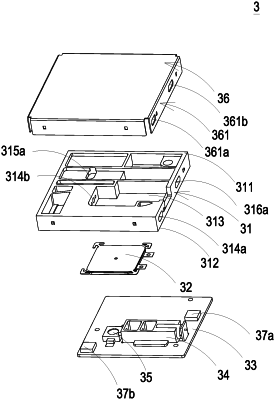| CPC G01N 15/06 (2013.01) [G01N 1/24 (2013.01); G01N 15/0205 (2013.01); G01N 2015/0693 (2013.01)] | 20 Claims |

|
1. A home device capable of gas detection, comprising:
a main body having at least one inlet, at least one outlet and a gas flowing channel disposed between the at least one inlet and the at least one outlet; and
a gas detection module, disposed in the gas flowing channel of the main body, comprising a base, a gas-inlet groove, a driving circuit board, an outer cover, a piezoelectric actuator and at least one sensor, wherein gas is inhaled into the gas flowing channel through the inlet, transported to the at least one sensor to be detected, and discharged out through the outlet by the piezoelectric actuator, so as to obtain gas information,
wherein the outer cover is attached to a first surface of the base, the driving circuit board is attached to a second surface of the base,
wherein the gas detection module includes a gas flowing path comprising a gas-inlet groove recessed from the second surface and on an upstream side of the at least one sensor, a gas-guiding-component loading region recessed from the second surface, opposite to the first surface, and on a downstream side of the at least one sensor, and a gas-outlet groove recessed from the first surface and on a downstream side of the gas-guiding-component loading region, and
wherein the gas flowing path is configured in such a manner that the gas passes the gas-inlet groove and the gas-outlet groove respectively in a direction parallel with the first and second surfaces.
|